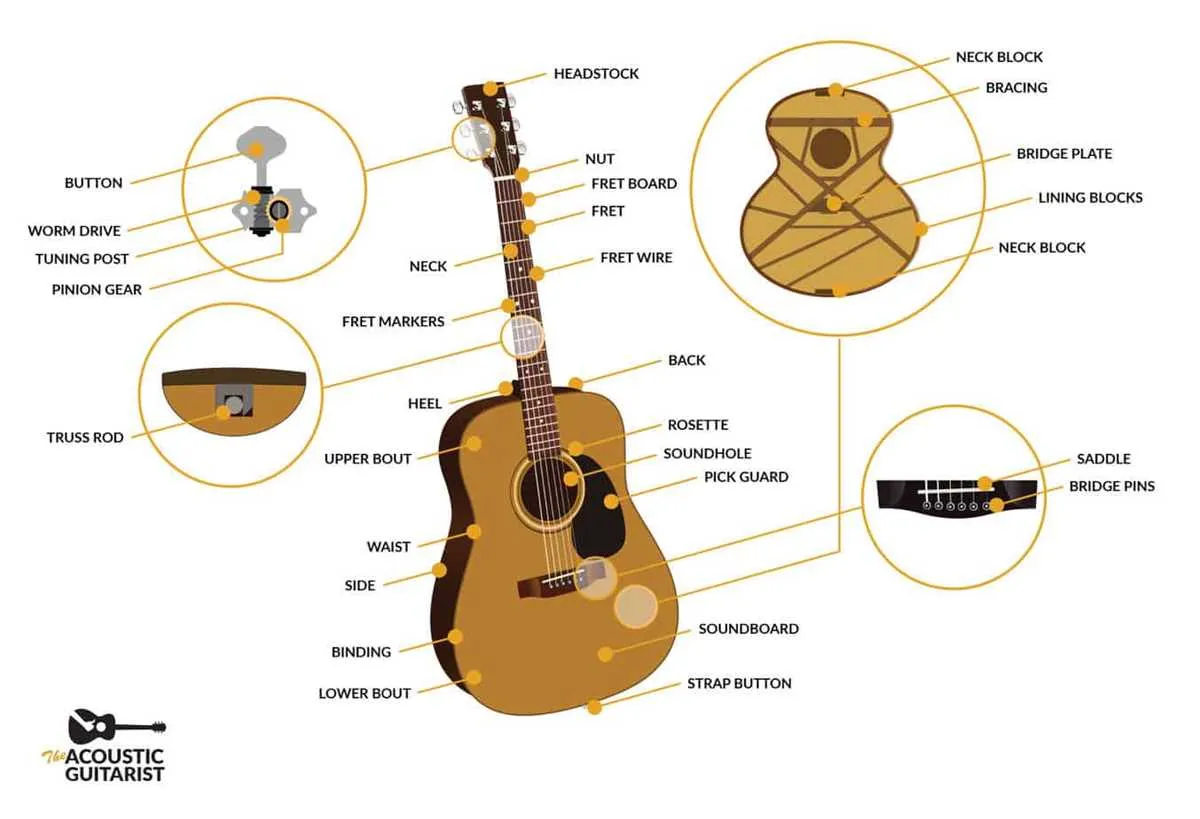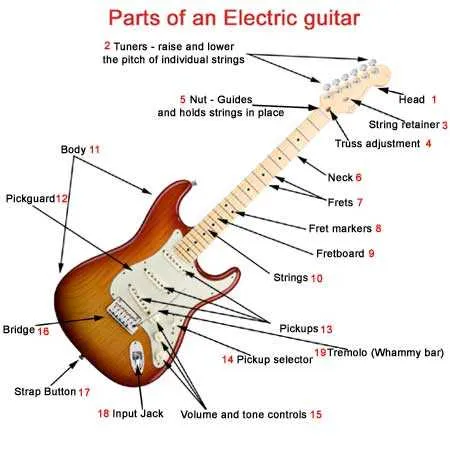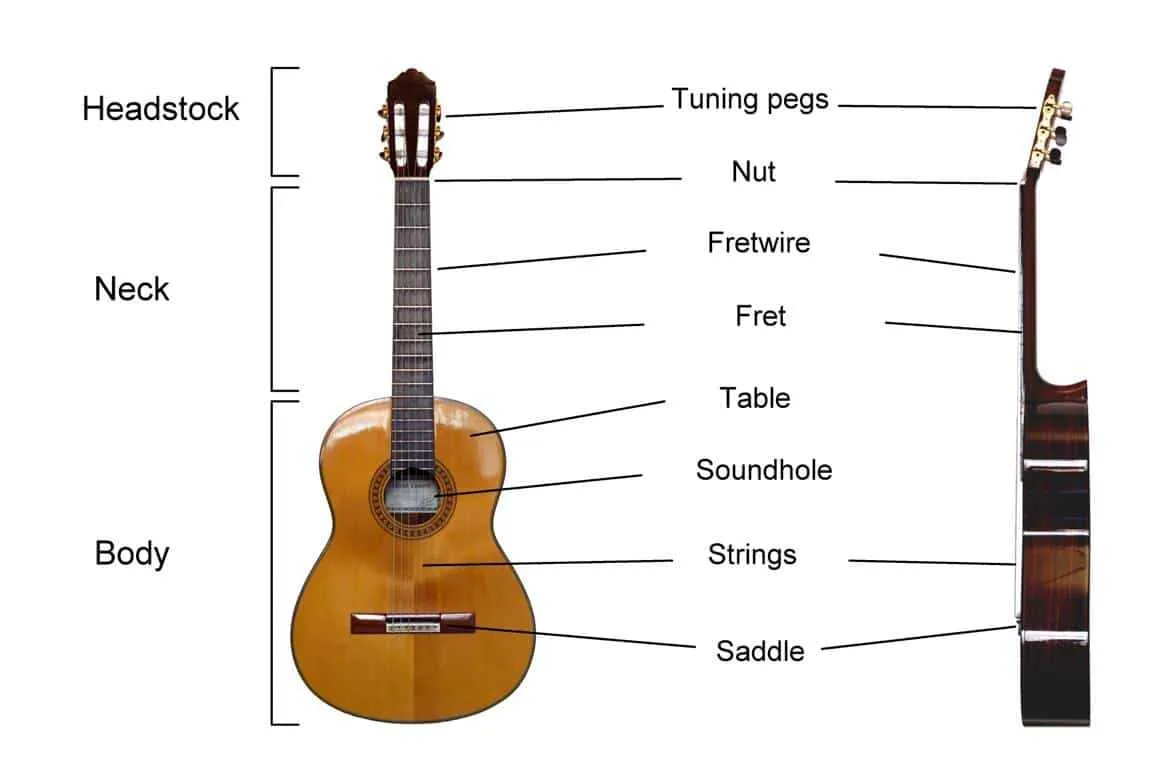
To improve your playing, it’s crucial to familiarize yourself with the main elements that shape the sound and playability of a stringed instrument. Knowing the roles of each section, from the resonator to the tuning mechanism, can dramatically enhance your musical performance. This knowledge aids in proper maintenance and provides a deeper appreciation for the craftsmanship behind the instrument.
For optimal resonance and tone quality, attention should be paid to the soundboard, which plays a significant role in amplifying vibrations. The bridge, located just below the strings, is another vital area, transferring vibrations from the strings to the body. Ensuring the proper alignment and tension here can drastically affect sound clarity.
Additionally, understanding the role of the neck and its connection to the headstock is essential. The neck’s curvature must be regularly adjusted for smooth playability, preventing buzzing or tuning issues. The nut, located at the joint between the neck and headstock, keeps the strings in proper alignment and tension, ensuring stable tuning throughout playing sessions.
Lastly, the pickguard, though often overlooked, serves both protective and aesthetic functions. It guards the surface against damage from strumming or picking while contributing to the overall look of the instrument.
Key Components of a Stringed Instrument Overview

The headstock, located at the top, houses the tuning pegs that are essential for adjusting string tension. The neck extends from the headstock and connects to the body, where the fingerboard is found. The fingerboard is where notes are played by pressing down on the strings with the fingers. In the middle of the neck, the truss rod can be adjusted to change the neck’s curvature for better playability and intonation.
The body is the large hollow section that amplifies the sound. The soundhole is found in the center of the top plate, helping to project the sound waves outward. The bridge, attached to the body’s lower part, anchors the strings in place. It also plays a critical role in transferring string vibrations to the top plate for sound production.
The saddle, positioned on the bridge, supports the strings and helps maintain string height, which affects both playability and tone. The nut, located where the neck meets the headstock, keeps the strings spaced evenly and at the proper height, ensuring a clean and consistent sound when played.
Understanding the function of each element helps in the setup and maintenance of the instrument, leading to better sound quality and ease of play.
Understanding the Body Structure: Top, Back, and Sides

The top, back, and sides of string instruments are crucial for shaping their sound and resonance. The top, typically made from spruce or cedar, plays a dominant role in determining the tonal quality. Choose a thin, solid wood top for better sound projection and responsiveness. It is vital to avoid laminated tops, as they lack the same resonance and durability as solid wood.
The back is often crafted from rosewood, mahogany, or maple. The material used impacts the warmth and depth of the sound. A thicker back enhances low-end frequencies, while a thinner back promotes midrange clarity. The back should also have a slight arch, contributing to a fuller sound.
The sides, made of materials like mahogany or walnut, are responsible for the overall shape and structural integrity of the instrument. Opt for thinner sides to maximize resonance without compromising strength. Well-constructed sides also ensure a balanced tone across frequencies, as they support the body’s vibration and overall sound quality.
Neck and Headstock: Key Components for Tuning and Playability
The neck and headstock are critical for maintaining accurate tuning and ensuring comfortable playing. Understanding their construction and function is essential for optimal performance.
Here are the main elements to focus on:
- Neck Material: Maple and mahogany are the most common woods used for necks. Maple offers stability and brightness, while mahogany provides warmth and depth. Choosing the right wood affects sustain and tone.
- Truss Rod: Located inside the neck, this adjustable metal rod helps to correct the curvature. Proper truss rod adjustment is key to avoiding fret buzz and achieving the best action for your needs.
- Fretboard: Made from rosewood, ebony, or maple, the fretboard’s material and finish affect feel and playability. Smoother finishes offer faster playability, while textured surfaces provide more grip for intricate fingerwork.
- Headstock: This part holds the tuning pegs, and its design influences string tension and stability. A well-designed headstock prevents unwanted shifting of the pegs during play.
- Tuning Pegs: High-quality tuners reduce slipping and improve accuracy when tuning. A 6-in-line configuration or a 3+3 design ensures efficient tuning and allows for better string angle control.
Regular inspection and maintenance of these components are necessary to prevent issues like tuning instability, fret wear, and diminished comfort during long sessions. Small adjustments, like tightening the truss rod or replacing worn tuners, can make a significant difference in overall playability.
Bracing Patterns: How They Affect Sound Quality and Resonance
When choosing a model, opt for a top reinforcement design that complements the tone you seek. For a balanced, well-rounded sound, traditional X-bracing is ideal. It enhances projection while maintaining tonal clarity. If you’re after a brighter, more focused tone, consider forward-shifted bracing, which allows for better high-end response and increased sustain.
Different patterns also influence the resonance and volume. Scalloped bracing, where the braces are shaved for a lighter construction, offers more dynamic range and increased resonance. It results in a rich, responsive sound, especially when played softly. However, it can be less stable in terms of long-term durability and tuning stability compared to heavier, non-scalloped designs.
Fan bracing, commonly seen in classical builds, emphasizes a warm, mellow tone, offering a softer attack but excellent note separation. Its efficiency in low-frequency response makes it popular for fingerstyle players. For musicians who prioritize a fuller, more substantial bass, this pattern could be a better match.
Lastly, modern “V” bracing provides exceptional clarity and sustain, offering a more responsive tone without sacrificing bass depth. It is ideal for contemporary styles where projection and precision are key. Understanding how each structure works with your playing style will refine your overall experience.